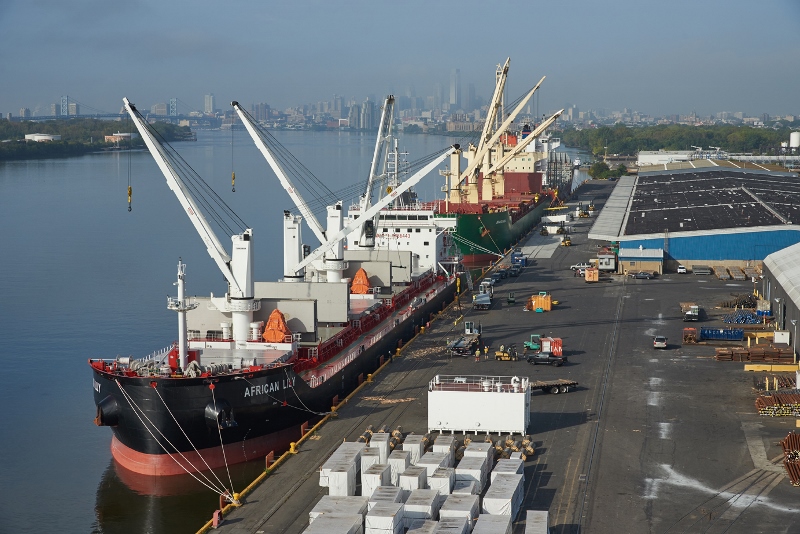Pennsylvania is pushing to capture more East Coast shipping with a $300 million capital investment in the Port of Philadelphia that will more than double container capacity and increase port employment by 70%, said Gov. Tom Wolf.
“This capital investment program will give the Port of Philadelphia the tools it needs to improve its competitive position and create thousands of family-sustaining, middle class jobs while increasing state revenues,” Wolf said in announcing the plan Tuesday. “With its major economic impacts throughout the state, my administration understands the value of Pennsylvania’s port asset in Philadelphia.”
State officials say the project to continue through 2020 will rank among the largest port infrastructure investments by a state on the East Coast, at a time when other ports, tugboat companies and harbor pilots are gearing up for the new generation of bigger ships coming through the widened Panama Canal.
About $200 million will be used to expand the main container operation at the Packer Avenue Marine Terminal in South Philadelphia, with other improvements to the port’s automobile shipping operations, and to the Tioga Marine Terminal in the city's Port Richmond section.
The Packer terminal improvements will come around the time the Corps of Engineers completes its Delaware River main channel deepening project, taking minimum depths down to 45’. Port officials say that will put them in the competition for larger container ships.
The container terminal will get four new electric post-Panamax container cranes that can reach across the beamier ships, relocation of warehouses to make room for more containers, plus new warehouses. Electrical service will be upgrade throughout the terminal so existing diesel powered cranes can be converted to electricity.
Philadelphia could also be one of the first East Coast ports to provide shore power for container vessels. The electrical upgrades will allow vessels to plug in rather than using onboard generation for power in port – also known as cold ironing.
California ports are already using shore power to reduce air emissions from port operations. This month the cruise liner Queen Mary 2 plugged in at the Brooklyn Cruise Terminal during its New York City port call, marking the first use of that shore power facility.
The Philadelphia Regional Port Authority (PRPA) predicts the improvements will at least double cargo-handling capacity at the Packer terminal, already the busiest in Philadelphia. In April PRPA officials said cargo volume through the entire port has increased 68% over six years, and broke through 6 million tons for the first time in 2015.
Container-handling capacity will especially increase, with a 900,000 TEU capacity immediately from the improvements, up from the 400,000-plus annual capacity now. Port officials say that could be scaled up to more than 1.2 million TEUs in years to come.
Tom Holt, Jr. of Holt Logistics, the parent company of Greenwich Terminals, LLC, which operates Packer Avenue Marine Terminal, said the improvements will “position us as one of the fastest growing container ports on the East Coast.”
About $90 million is earmarked for the port’s automobile facility operated by Glovis America, Inc., adjacent to the Packer terminal, where some 300 workers process 150,000 cars a year including Hyundai and Kia cars for distribution to eastern U.S. dealerships. Improvements will include paving and fencing 155 acres above the river flood plain at the Southport site, and converting a former seaplane hangar there into a second auto-processing facility. The main auto-processing site at Pier 98 Annex will get improvements, and the port will establish a system for flexible use of land for story containers and cars as determined by market conditions.
The goal is to increase car handling capacity by 166%.
“The addition of space and ability to consolidate our foot print at the port improves our ability to make Philadelphia an aggressive cost competitive port. It also ensures our long-term commitment to grow jobs and revenues in the Commonwealth.” said Glovis president and CEO Glenn Clift.
Tioga Marine Terminal, operated by Delaware River Stevedores, will get $12 million for improvements to the main on-dock warehouse that has been handling and processing Brazilian wood pulp cargoes since 2014. A second warehouse at Tioga will be converted into a food-grade warehouse, allowing the Port increase its wood pulp volumes to meet the demands of Pennsylvania companies that use pulp. Improved rail access and the purchase of a second mobile harbor crane will also add capacity at Tioga.





